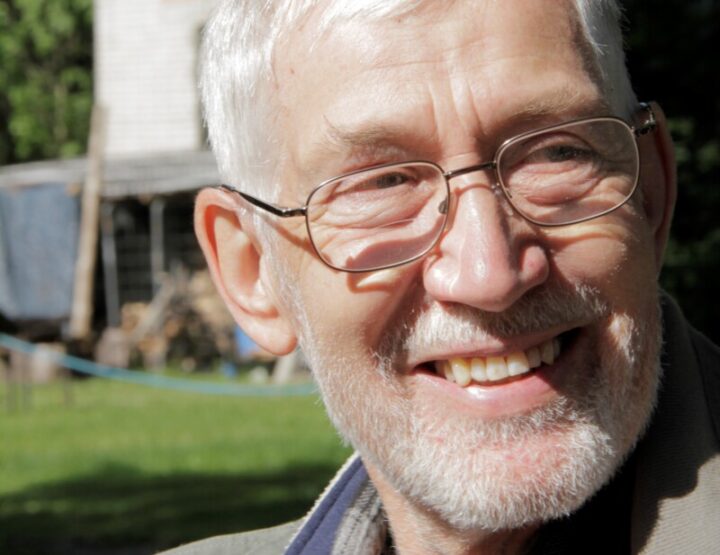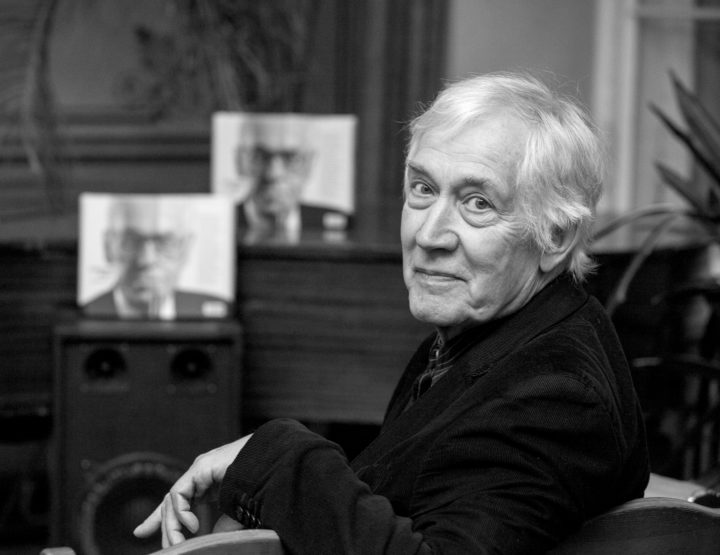Ecological thinking lies at the core of Jaan Kaplinski’s (1941–2021) diverse catalogue. His poetry, prose, essays, and general outlook on life were grounded in the quest to achieve a dynamic balance between humans and nature. Life was Kaplinski’s primary focus: how it can be understood, how to ensure its continuity, and how to attain a meaningful existence. “What can I do – I’m an ecologist by heart,” he remarked in what was his last book, In and With Nature (2020).
Kaplinski’s ecological thinking was noticed early on. After the writer received the Juhan Liiv Prize for Poetry in 1968, Estonian environmentalist and biogeographer Jaan Eilart wrote: “An understanding of nature’s naturalness and an endeavor to preserve all conceivable forms of life are central themes in the laureate’s poetry. They spring from seeing nature through eyes unclouded by the allures of urbanization, as well as from generally picking apart the relationships between humanity, culture, and the environment in an original and philosophical way. […] In today’s world, individual species are no longer in danger, but life itself. Destroying the ties that bind life together inevitably leads to catastrophe. Life needs protection!”
Today, Kaplinski’s ecological writing has acquired new relevancy. An ever-keener awareness of human responsibility for the environmental crisis (climate change, epidemics, etc.), the declaration of a new geological era (the Anthropocene), and a reevaluation of the relationship between nature and culture give us an opportunity to read Kaplinski with a fresh perspective and seek solutions to today’s problems in his works.
What Kaplinski has to say to us now, as we find ourselves amidst an intensifying environmental crisis, is intriguing; what can we take from his writing for life in the Anthropocene? His ecological essays were published over the course of half a century: the first significant pieces in the early 1970s (e.g. “Ecology and Economics” and “Thoughts on Ecosystems and Human Culture”) and the last, by that time with an autobiographical air, in the last decade (e.g. In and With Nature).
How does one become an ecological thinker?
Before we become acquainted with Kaplinski’s views on nature, it is pertinent to address the sources of his ecological thinking. As the author himself acknowledged, his interest in ecology extended into early childhood. There were memorable long walks through nature with his maternal grandfather, who taught him the names of flora and fauna, and childhood summers spent in the forests and bogs of South Estonia, which quickly became his dearest home. Books soon complemented Kaplinski’s direct communication with the natural world: initially nonfiction come across at the summer cottage and elsewhere (Kaplinski specifically mentioned Bernhard Grzimek’s nature books, excerpts of which he later translated into Estonian), but later branching out into foreign-language literature on ecology, biology, ethnography, and anthropology, which found its way to him by a variety of means. It is important to note that Kaplinski’s deep fascination with indigenous cultures and religious rituals was closely tied to his ecological interests – often, he searched for solutions to the western world’s ecological crisis in the experiences of traditional cultures.
Albert Schweitzer became an important philosophical role model for Kaplinski, especially his teachings on Reverence for Life. Of no less importance, however, were Kaplinski’s contemporaries in America – particularly Gary Snyder, with whom he became a long-time pen pal. Significant impulses also came from Beatniks’ hippie-like kinship with nature and Native American beliefs. Kaplinski fostered close communication with Estonian naturalists at an early age and emphasized the role of biologist Viktor Masing in shaping his views. He additionally worked at the Tallinn Botanical Garden from 1974–1980, during which time he was surrounded by biologists, botanists, and ecologists.
The Bases of Kaplinski’s Ecological Thinking
Kaplinski’s ecological worldview can essentially be boiled down to three principles.
The first is holism. As Kaplinski saw it, life forms a complete network in which everything is interconnected and interdependent. “Life is like a dance or music dominated not by a causal, but a holistic relationship; where everything is united and connected.” (“Ice and the Titanic”, 1995). In a 1972 article titled “The Axe and the Tree”, he stated, “For us, the world is not merely a dance floor filled with couples of Causes and Effects, but a chess match in which the movement of any one piece changes the state of the entire game.” The clearest expression of Kaplinski’s belief that life is a network appeared in his 2000 travelogue Spring on Two Coasts, or A Sentimental Journey to America: “In fact, Life on Earth is not a chain, but a web, a network. If a knot or an eyelet breaks then it is still a web, albeit broken. Earth’s biosphere is currently a broken web, one so vital to us all. It is broken but still working.”
Secondly is the principle of anti-economism. Life cannot be subjected to economic thinking, which tends to view people as value-creators and thus believe that more work equals more value. Economic thinking leads to environmental destruction and devastation. Ecology is uneconomic. Kaplinski wrote his first methodological essay on this in 1972, titled: “Ecology and Economy”. In it, he juxtaposes the two manners of thought: “The enemy of ecological thinking is therefore not economics, but the ideology and economic thinking that are associated with it – a mindset that presently holds the world in its clutches.” A few years later, he wrote in a portentous essay titled “Insects and People” (1976): “We will undoubtedly face catastrophe if we do not learn to want less and limit our consumption, which inherently entails increased exploitation of the biosphere.”
Thirdly, the principle of pluralism. In much of his writing, Kaplinski emphasized that reducing nature’s diversity weakens its self-regulating mechanisms. As a member of a tiny nation, he expressed equal appreciation for natural and cultural diversity, writing in 1972: “The biosphere is very strange and our cautious existence in it can be summarized with the slogan ‘reverence for information’. For not one genotype, community, language, or culture can be restored if they should disappear.” Pluralism is even more apparent in his 2004 philosophical short story “Ornithophilosophy, or The Notes of Nestor the Raven”: “Diversity is unavoidably vital to life and cognition alike. The sooner that humans understand it, the better.”
Diagnosis: The Ecological Situation
Kaplinski’s perception of today’s global ecological situation was highly pessimistic. The preservation of natural diversity was one of his greatest concerns, as he was convinced that humankind is taking more from the environment than can be restored through its renewal. Humanity has become a force of natural destruction, which simultaneously means self-destruction. Our most pressing problem is that we have thrown ecosystems out of balance – the preservation of more and more ecosystems and their unique elements has become dependent on humans. We are actively contributing to the simplification of ecosystems, which inevitably results in sudden, negative changes.
We encounter Kaplinski’s critical opinion of human behavior in his earliest essays. In 1972, he complained: “Mankind has acted like a poorly-adjusted parasitic population that expends available resources faster than they are capable of regenerating, thereby drifting towards ruin.” His outlook was equally critical in a 2001 speech he gave in Paris, titled “Globalization: For or Against Nature?”: “At present, mankind is drastically changing nature itself due to demographic explosion and the increasing exploitation of natural resources. As a result, nature, both animate and inanimate, is becoming more unstable, prone to bigger vacillations. As we humans are always a part of nature and cannot escape these vacillations; we are more exposed to droughts, storms, famines, and epidemics.”
Habitat destruction is suicidal from a holistic view because by laying waste to nature, we are only laying waste to ourselves. Kaplinski detailed this with striking imagery in his prose poem “Ice and Heather” (1989): “In fact, trees and shrubs are a part of us – they are simply at a greater distance from our body than hands or feet, so it is possible to assume that they don’t feel pain; that chopping away our branches and trunks doesn’t cause us serious injury. But we cannot live without trees. The fewer trees there are, the less we live. In reality, we are chopping up and cutting down parts from our own body; we are burning and poisoning ourselves.”
Solutions: Ecological Thinking
Pessimistic diagnoses of the state of the world are abundant, to say the least. However, the value of Kaplinski’s writing for the modern reader lies foremost in his proposals for how to emerge from the crisis. In the interests of symmetry, I will select three from his extensive catalog.
First, a shift in thinking and in imagination. According to Kaplinski, improving the ecological situation starts with a change in thought; by replacing economic thinking with ecological thinking. Life-endangering dreams must be replaced with ones that cause no harm. In the essay “Ecology and Economy”, he advises: “While man’s own ‘sensible’ activity constitutes the greatest threat to the ecosystem today, the goal of ecological thinking is to critique this ‘sense of sensibility’. It is evolutionary criticism of our worldview to date.” He makes not only an appeal to reason, but to imagination: “There are two possible courses of action: either we slow the economic engine, refrain from accelerating, and leave most of our dreams unfulfilled, or we change the dreams themselves and dream only of what isn’t dangerous to achieve.”
Secondly, the new self-regulation of mankind. Kaplinski believes it is possible to alter the relationships between humans and nature by consciously adjusting our behavior. In his 1973 essay “Thoughts on Ecosystems and Human Culture”, he found that the history of human development seems to prove that we once possessed an ability to self-regulate, similar to other species: “If the stability of the ecosystem hinges greatly upon human activity, then man has, in principle, the opportunity to preserve or even restore stability by steering that ecosystem via his own actions. Man can govern nature by governing himself.”
Thirdly, and most importantly, humankind as a whole can learn how to think ecologically and consciously regulate our behavior based on the experiences of peoples that exist within nature (i.e. from ethnographical and anthropological literature). Kaplinski’s ecological worldview has strong roots in anthropology and one of his primary long-term interests was searching for ties between religion and ecological thinking. In 1972, he stated: “For peoples living in nature […], the very best strategy is no doubt to believe in their spirits and myths; to abide by their taboos. That will guarantee the stability of life and habitat.” A year later, he suggested that the environmental behavior of traditional societies is culturally regulated: “Although most nature-peoples had the means to extract much more from the environment than was safe for it, they refrained from taking such measures and thus preserved the ecosystem’s stability. This mechanism limiting environmental exploitation is not genetic, but cultural, forming over millennia of cultural revolution.”
In short, Kaplinski’s message to today’s world is this: mankind’s sole chance to survive in the Anthropocene is to learn to consider all living beings as an interconnected web, to exist in a way that disturbs as few other living beings as possible, and to seek an optimal balance between our needs and the environment’s possibilities. This will require a tremendous revolution of human thought; a cultural shift that places our attitude towards nature on new foundations that lie beyond simplistic contrasts such as culture vs. nature and humans vs. animals.




